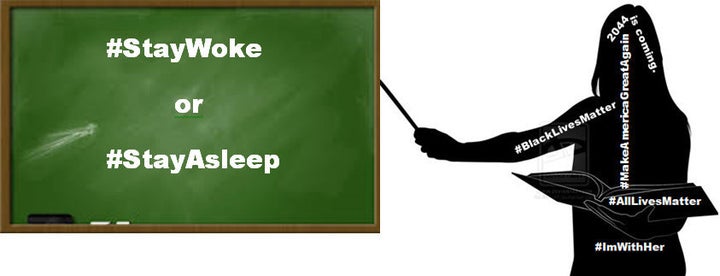
Students of color want to know if we are allies or foes,
because there is no in-between.
Even though I’ve taught sixteen first days of school, I’ll still have night-before jitters and try on personas that would rival Ali’s infamous boxing weigh-ins. This summer of racial turmoil is a game changer for the fast-approaching first day of school. My students will size me up with razor-sharp analyses shaped by public executions, presidential promises, patriotism and terror.
People of color are mourning fallen sons and daughters while mobilizing for justice. Simultaneously, white folks’ defensiveness and fear have reached a fever pitch. Because of this potent combination, the criteria by which teachers and students judge one another will be more racialized and politicized than usual.
Ultimately, white teachers’ responses to this American kairotic moment have the potential to support or destroy generations of students.
Did that last statement strike you as too dramatic? Think of how young Malcolm Little’s dreams of becoming a lawyer were crushed by his teachers’ biases. Or, how research demonstrates that students’ perceptions of what their teachers expect from them are the strongest predictor of academic engagement, desire to learn, willingness to help classmates, and interest level in class. Or, how unless we have knowledge of our students’ cultures, we can’t reach Vygotsky’s Zone of Proximal Development where optimal learning occurs.
As white teachers, we simply must improve (and I’m not talking about test scores). Middle and high school students will hashtag us within the first few moments of class. At this crossroad our potential labels are: #BlackLivesMatter, #AllLivesMatter, #MakeAmericaGreatAgain, or #ImWithHer. They will read our verbal and non-verbal signs and swiftly assign us to one of the controversial camps. We need to prepare ourselves for this reality now, before the first bell rings.
Like most American educators, I am a white, middle-class female and my students are not. Almost all of my alternative education students qualify for free lunch, several are first or second generation war refugees from Bosnia or Iraq, some are Albanian American, others are Hmong American, there’s a small pocket of white Americans, and the remaining majority are African American. Those racial demographics also intersect complex religious identities which compel students to become offensive and defensive players in a micro-level classroom holy war.
Now more than ever, white teachers must open our eyes to our students’ perspectives if we want to reach and teach. Although it may be simply ideological for us, the causes and effects of the Black Lives Matter movement are literally life and death for our African American students. Students of color want to know if we are allies or foes, because there is no in-between.
Additionally, the upcoming presidential election (and its accompanying incendiary rhetoric) strike cords of anxiety for our students. Some of their concerns are unfamiliar to the white community: Who will/won’t fixate on my imaginary bootstraps? Who will/won’t deport my family? Who will/won’t order drone strikes that turn my cousins into collateral damage? Who will/won’t include me in the Bill of Rights?
It is a choice to become a culturally responsive teacher or
a culturally irresponsive teacher.
Most white teachers have never lived as a minority within a community of color, so we don’t have the collective experience necessary to relate to non-white students. How can we become more effective educators and responsibly meet our students’ needs that were revealed this summer? Despite what Trump Jr. says, we’re already busy preparing for the school year. Let’s squeeze in some summer reading selections that illuminate some ignored perspectives.
If you want to learn how to elevate teaching from a profession into an inclusive vocation, read bell hooks’ Teaching to Transgress: Education as the Practice of Freedom. To learn the history of Americans who lost power (or never had any to begin with), study Howard Zinn’s A People’s History of the United States. If you value becoming a multicultured educator, delve into Gary Howard’s We Can’t Teach What We Don’t Know: White Teachers, Multiracial Schools. For insight into students’ experiences in post-9/11 America, digest Cindy Long’s article in NEAToday “Maligned and Misunderstood: Muslim Students Speak Out”. To nurture empathy for and understanding of growing up black in America, explore Ta-Nehisi Coates’ Between the World and Me. I also recommend a good old-fashioned Google search for “culturally responsive lesson plans”.

I have the sacred advantage of being an English teacher to whom my students share their authentic thoughts and feelings. I have mindfully listened to, read, and sat in silence with my students’ experiences of learning in an environment sculpted by and for a white viewpoint.
I made the conscious decision to stay woke.
Then, I wrote a poem to reflect what my students of color have shared; a poem that embodies factual, raw student perceptions of the white teachers who choose to stay asleep:
White Teacher, I see you. I know you want to erase the brown from my skin like yesterday’s algorithm.
Tick tock. 2044 is coming. Tick tock. You’ll be one of us - a minority, inferiority, suspect
White Teacher,
you cloak your imaginings
of Ellis Island with a sepia filter
and claim the story ended
when slavery did;
a distant sin that your people weren’t in.
You dismiss me like school bells, shouting It wasn’t me, it wasn’t me!
But I’m a kid and I know playground rules:
the one who says it wasn’t me
is the one it always is.Tick tock. 2044 is coming. Tick tock. You’ll be one of us - a minority, inferiority, suspect
White Teacher,
you ban me from speaking my language
in your classroom
because it’s America you say.
In America, I was lullabied to sleep in my language.
In America, my father whispered goodbye, I’m sorry in my language.
In America, there is no one language;
lest you count Iroquois or Cree.Tick tock. 2044 is coming. Tick tock. You’ll be one of us - a minority, inferiority, suspect
White Teacher,
I was taught you have the answers.
But do you ever question?
My Eastward Invasion is
your Westward Expansion.
You find me too loud and my gestures distracting;
but, you, you’re strangely quiet
and your stillness is unsettling.Tick tock. 2044 is coming. Tick tock. You’ll be one of us - a minority, inferiority, suspect
White Teacher,
after Nine Eleven, you became my terrorist.
Giving me side-eye like my hijab is an IED,
like Allah doesn’t mean God,
and like religion isn’t free.Tick tock. 2044 is coming. Tick tock. You’ll be one of us - a minority, inferiority, suspect
White Teacher,
even Crayola changed flesh to peach in ‘62,
when and what will it take for you?
You move your family farther north
for better schools; but I know
you’re really moving further away from me.Tick tock. 2044 is coming. Tick tock. Hold up. Stop the clock. 2044 is only for grown-ups. By 2020, your kids become one of us - minorities, inferiorities, suspects
White Teacher,
what will happen when your baby loses privileges?
Will you still let him wear a hoodie
or shoot bullets shaped like Skittles?Tick tock. 2044, 2020, 2016, right now, this moment, this second
White Teacher,
I can’t trust you.
I used to think that the alliance between student and teacher was invulnerable. I know now that our trust is broken. As a culturally responsive educator, I will work to earn the trust of my students. They more than deserve it.
